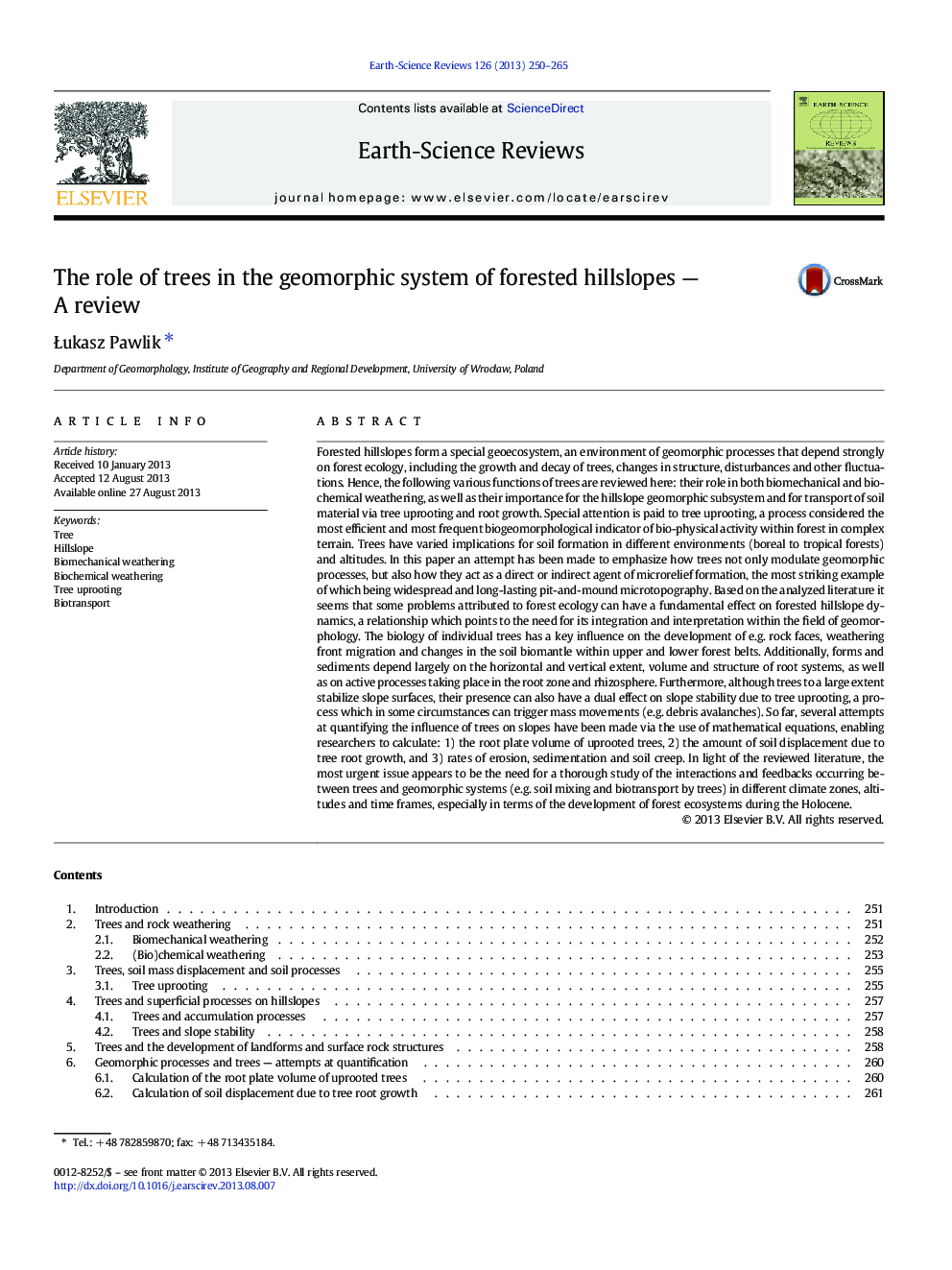| کد مقاله | کد نشریه | سال انتشار | مقاله انگلیسی | نسخه تمام متن |
|---|---|---|---|---|
| 6443095 | 1639976 | 2013 | 16 صفحه PDF | دانلود رایگان |
عنوان انگلیسی مقاله ISI
The role of trees in the geomorphic system of forested hillslopes - A review
ترجمه فارسی عنوان
نقش درختان در سیستم ژئومورفیک تالاب های جنگلی - بررسی
دانلود مقاله + سفارش ترجمه
دانلود مقاله ISI انگلیسی
رایگان برای ایرانیان
ترجمه چکیده
تپه های جنگل های معلق یک ژئواکسیستم خاص و محیطی از فرآیند های ژئومورفیک را تشکیل می دهند که به شدت به محیط زیست جنگل، از جمله رشد و تخریب درختان، تغییر ساختار، اختلالات و دیگر نوسانات بستگی دارد. از این رو، توابع مختلف زیر درختان مورد بررسی قرار می گیرند: نقش آنها در هر دو فرسایش بیومکانیک و بیوشیمیایی، و همچنین اهمیت آنها برای زیر سیستم ژئومورفیک تپه ها و انتقال مواد خاک از طریق ریشه زایی درختان و رشد ریشه. توجه خاص به زاد و ولد درختی است که فرایند به عنوان مهمترین و مؤثرترین شاخص بیوگرافی شناختی فعالیت زیستی فیزیکی در جنگل در زمین پیچیده محسوب می شود. درختان دارای پیامدهای متنوعی برای تشکیل خاک در محیط های مختلف (جنگل های بومی تا گرمسیری) و ارتفاعات هستند. در این مقاله تلاش شده تا تاکید کنیم که چگونه درختان نه تنها فرآیندهای ژئومورفیک را مدول می کنند، بلکه همچنین این که چگونه آنها به عنوان یک عامل مستقیم یا غیرمستقیم از تشکیل میکرولایفیک عمل می کنند، قابل توجه ترین نمونه ای که از آن می توان به عنوان گودال و گودال گسترده و بلند مدت میکروتاپوگرافی بر اساس ادبیات تجزیه و تحلیل شده به نظر می رسد که برخی از مشکلات مربوط به محیط زیست جنگل می تواند تأثیر بنیادی بر دینامیک تپه های جنگل داشته باشد، که ارتباط آن با نیاز به ادغام و تفسیر آن در حوزه ژئومورفولوژی را نشان می دهد. زیست شناسی درختان فردی تاثیر کلیدی بر توسعه از قبیل چهره های سنگی، مهاجرت رو به جلو هوا و تغییرات در خاک بیومانت در تسمه های جنگلی بالا و پایین. علاوه بر این، اشکال و رسوبات عمدتا به حجم افقی و عمودی، حجم و ساختار سیستم های ریشه، و همچنین در فرایندهای فعال در منطقه ریشه و ریزوسفر بستگی دارد. علاوه بر این، اگر چه درخت ها تا حد زیادی سطح شیب را تثبیت می کند، حضور آنها همچنین می تواند تاثیر دوگانه ای بر ثبات شیب را داشته باشد که به دلیل برداشتن درخت، فرآیندی است که در برخی موارد می تواند جنبش های توده ای را باعث شود (به عنوان مثال، آوارهای باقیمانده). تاکنون چندین تلاش برای اندازه گیری تاثیر درختان در دامنه ها بوسیله استفاده از معادلات ریاضی ساخته شده است، که محققان قادر به محاسبه آن هستند: 1) حجم ریشه صفحات درختان ریشه دار، 2) مقدار جابجایی خاک به دلیل رشد ریشه درخت و 3) میزان فرسایش، رسوبگذاری و خزش خاک. با توجه به ادبیات تجدید نظر شده، موضوع فوری به نظر می رسد نیاز به مطالعه کامل در تعاملات و بازخورد بین درختان و سیستم های ژئومورفیک (به عنوان مثال مخلوط کردن خاک و حمل زیستی درختان) در مناطق مختلف آب و هوایی، ارتفاعات و فریم های زمانی، به خصوص از نظر توسعه اکوسیستم های جنگلی در طی هولوسن.
موضوعات مرتبط
مهندسی و علوم پایه
علوم زمین و سیارات
زمین شناسی
چکیده انگلیسی
Forested hillslopes form a special geoecosystem, an environment of geomorphic processes that depend strongly on forest ecology, including the growth and decay of trees, changes in structure, disturbances and other fluctuations. Hence, the following various functions of trees are reviewed here: their role in both biomechanical and biochemical weathering, as well as their importance for the hillslope geomorphic subsystem and for transport of soil material via tree uprooting and root growth. Special attention is paid to tree uprooting, a process considered the most efficient and most frequent biogeomorphological indicator of bio-physical activity within forest in complex terrain. Trees have varied implications for soil formation in different environments (boreal to tropical forests) and altitudes. In this paper an attempt has been made to emphasize how trees not only modulate geomorphic processes, but also how they act as a direct or indirect agent of microrelief formation, the most striking example of which being widespread and long-lasting pit-and-mound microtopography. Based on the analyzed literature it seems that some problems attributed to forest ecology can have a fundamental effect on forested hillslope dynamics, a relationship which points to the need for its integration and interpretation within the field of geomorphology. The biology of individual trees has a key influence on the development of e.g. rock faces, weathering front migration and changes in the soil biomantle within upper and lower forest belts. Additionally, forms and sediments depend largely on the horizontal and vertical extent, volume and structure of root systems, as well as on active processes taking place in the root zone and rhizosphere. Furthermore, although trees to a large extent stabilize slope surfaces, their presence can also have a dual effect on slope stability due to tree uprooting, a process which in some circumstances can trigger mass movements (e.g. debris avalanches). So far, several attempts at quantifying the influence of trees on slopes have been made via the use of mathematical equations, enabling researchers to calculate: 1) the root plate volume of uprooted trees, 2) the amount of soil displacement due to tree root growth, and 3) rates of erosion, sedimentation and soil creep. In light of the reviewed literature, the most urgent issue appears to be the need for a thorough study of the interactions and feedbacks occurring between trees and geomorphic systems (e.g. soil mixing and biotransport by trees) in different climate zones, altitudes and time frames, especially in terms of the development of forest ecosystems during the Holocene.
ناشر
Database: Elsevier - ScienceDirect (ساینس دایرکت)
Journal: Earth-Science Reviews - Volume 126, November 2013, Pages 250-265
Journal: Earth-Science Reviews - Volume 126, November 2013, Pages 250-265
نویسندگان
Åukasz Pawlik,
